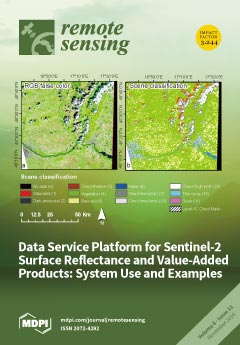1
Geohazards InSAR Laboratory and Modeling Group (InSARlab), Geoscience Research Department, Geological Survey of Spain (IGME), Alenza 1, 28003 Madrid, Spain
2
Research Partnership Unit IGME-UA on Radar Interferometry Applied to Ground Deformation (UNIRAD), University of Alicante, P.O. Box 99, 03080 Alicante, Spain
3
Spanish Working Group on Ground Subsidence (SUBTER), UNESCO, 03690 Alicante, Spain
4
Environmental Geology and Geomathematics, Geoscience Research Department, Geological Survey of Spain (IGME), Alenza 1, 28003 Madrid, Spain
5
Departamento de Ingeniería Civil, Universidad Católica San Antonio de Murcia, Campus de los Jerónimos, 30107 Murcia, Spain
6
Earth Observation and Geohazards Expert Group (EOEG), EuroGeoSurveys, the Geological Surveys of Europe, 36-38, Rue Joseph II, 1000 Brussels, Belgium
7
Centre Tecnològic de les Telecomunicacions de Catalunya (CTTC), 08860 Castelldefels, Barcelona, Spain
8
Leica Geosystems, s.l. Ctra Fuencarral, 28108 Alcobendas, Madrid, Spain
9
Department of Earth Sciences, Environment and Resources, Federico II University of Naples, Largo San Marcellino 10, 80138 Naples, Italy
10
Dpto.de Ingeniería Topográfica y Cartografía, Universidad Politécnica de Madrid, 28031 Madrid, Spain
11
Dpto. de Geología y Geoquímica, Facultad Ciencias, Universidad Autónoma de Madrid, 28049 Madrid, Spain
add
Show full affiliation list
remove
Hide full affiliation list
Abstract
Land subsidence resulting from groundwater extractions is a global phenomenon adversely affecting many regions worldwide. Understanding the governing processes and mitigating associated hazards require knowing the spatial distribution of the implicated factors (piezometric levels, lithology, ground deformation), usually only known at discrete locations.
[...] Read more.
Land subsidence resulting from groundwater extractions is a global phenomenon adversely affecting many regions worldwide. Understanding the governing processes and mitigating associated hazards require knowing the spatial distribution of the implicated factors (piezometric levels, lithology, ground deformation), usually only known at discrete locations. Here, we propose a methodology based on the Kriging with External Drift (KED) approach to interpolate sparse point measurements of variables influencing land subsidence using high density InSAR measurements. In our study, located in the Alto Guadalentín basin, SE Spain, these variables are GPS vertical velocities and the thickness of compressible soils. First, we estimate InSAR and GPS rates of subsidence covering the periods 2003–2010 and 2004–2013, respectively. Then, we apply the KED method to the discrete variables. The resulting continuous GPS velocity map shows maximum subsidence rates of 13 cm/year in the center of the basin, in agreement with previous studies. The compressible deposits thickness map is significantly improved. We also test the coherence of Sentinel-1 data in the study region and evaluate the applicability of this methodology with the new satellite, which will improve the monitoring of aquifer-related subsidence and the mapping of variables governing this phenomenon.
Full article





